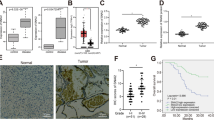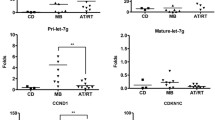Abstract
Neuroblastoma (NB) is the most common extra-cranial solid pediatric tumor. The prognosis of patients with NB has been improved during the last decades. However, treatment results for patients with advanced tumor stages are still unsatisfying. NB cells are characterized by a high tendency for spontaneous or induced differentiation. During differentiation, down-regulation of the basic helix-loop-helix transcription factor achaete-scute complex homolog 1 (ASCL1) has been observed but the consequences of ASCL1 down-regulation have not been elucidated. We used RNA interference to knock-down ASCL1 in NB cells. DNA microarray analysis was used for the identification of ASCL1-regulated genes. Furthermore, conventional and quantitative reverse transcription-polymerase chain reaction (RT-PCR) was used for validation of ASCL1-regulated genes. Down-regulation of ASCL1 influenced the expression of several genes. After down-regulation of ASCL1, we observed very high expression of insulin-like growth factor 2 (IGF2), a factor that is known to be induced during differentiation of NB cells. RT-PCR indicated up-regulation of multiple IGF2 transcript variants after ASCL1 knock-down. Our data suggest that the ASCL1-pathway is responsible for the up-regulation of IGF2 during NB differentiation.






Similar content being viewed by others
References
Spix C, Pastore G, Sankila R, Stiller CA, Steliarova-Foucher E (2006) Neuroblastoma incidence and survival in European children (1978–1997): report from the Automated Childhood Cancer Information System project. Eur J Cancer 42:2081–2091
Guillemot F, Lo LC, Johnson JE, Auerbach A, Anderson DJ, Joyner AL (1993) Mammalian achaete-scute homolog 1 is required for the early development of olfactory and autonomic neurons. Cell 75:463–476
Meredith A, Johnson JE (2000) Negative autoregulation of Mash 1 expression in CNS development. Dev Biol 222:336–346
Axelson H (2004) The Notch signaling cascade in neuroblastoma: role of the basic helix-loop-helix proteins HASH-1 and HES-1. Cancer Lett 204:171–178
Morgan TH (1917) The theory of the gene. Am Nat 51:513–544
Artavanis-Tsakonas S, Rand MD, Lake RJ (1999) Notch signaling: cell fate control and signal integration in development. Science 284:770–776
Liu WM, Laux H, Henry JY, Bolton TB, Dalgleish AG, Galustian C (2010) A microarray study of altered gene expression in colorectal cancer cells after treatment with immunomodulatory drugs: differences in action in vivo and in vitro. Mol Biol Rep 37:1801–1814
Sharma VM, Draheim KM, Kelliher MA (2007) The Notch1/c-Myc pathway in T cell leukemia. Cell Cycle 6:927–930
Hoennscheidt C, Max D, Richter N, Staege MS (2009) Expression of CD4 on Epstein–Barr virus-immortalized B cells. Scand J Immunol 70:216–225
Metzler M, Staege MS, Harder L, Mendelova D, Zuna J, Fronkova E, Meyer C, Flohr T, Bednarova D, Harbott J, Langer T, Gesk S, Trka J, Siebert R, Dingermann T, Marschalek R, Niemeyer C, Rascher W (2008) Inv(11)(q21q23) fuses MLL to the Notch co-activator mastermind-like 2 in secondary T-cell acute lymphoblastic leukemia. Leukemia 22:1807–1811
Biedler JL, Helson L, Spengler BA (1973) Morphology and growth, tumorigenicity, and cytogenetics of human neuroblastoma cells in continuous culture. Cancer Res 33:2643–2652
Ross RA, Spengler BA, Biedler JL (1983) Coordinate morphological and biochemical interconversion of human neuroblastoma cells. J Natl Cancer Inst 71:741–747
Staege MS, Hansen G, Baersch G, Burdach S (2004) Functional and molecular characterization of interleukin-2 transgenic Ewing tumor cells for in vivo immunotherapy. Pediatr Blood Cancer 43:23–34
Sturn A, Quackenbush J, Trajanoski Z (2002) Genesis: cluster analysis of microarray data. Bioinformatics 18:207–208
Staege MS, Banning-Eichenseer U, Weissflog G, Volkmer I, Burdach S, Richter G, Mauz-Körholz C, Föll J, Körholz D (2008) Gene expression profiles of Hodgkin’s lymphoma cell lines with different sensitivity to cytotoxic drugs. Exp Hematol 36:886–896
Foell JL, Hesse M, Volkmer I, Schmiedel BJ, Neumann I, Staege MS (2008) Membrane-associated phospholipase A1 beta (LIPI) is an Ewing tumour-associated cancer/testis antigen. Pediatr Blood Cancer 51:228–234
Livak KJ, Schmittgen TD (2001) Analysis of relative gene expression data using real-time quantitative PCR and the 2 (−Delta Delta C (T)) method. Methods 25:402–408
Reuter JS, Mathews DH (2010) RNAstructure: software for RNA secondary structure prediction and analysis. BMC Bioinform 11:129
Liangliang X, Yonghui H, Shunmei E, Shoufang G, Wei Z, Jiangying Z (2010) Dominant-positive HSF1 decreases alpha-synuclein level and alpha-synuclein-induced toxicity. Mol Biol Rep 37:1875–1881
Xu K, Wang X, Tian C, Shi S, Wang GR, Shi Q, Li P, Zhou RM, Jiang HY, Chu YL, Dong XP (2009) Transient expressions of doppel and its structural analog prionDelta32-121 in SH-SY5Y cells caused cytotoxicity possibly by triggering similar apoptosis pathway. Mol Biol Rep. doi:10.1007/s11033-009-9772-3
Ghosh C, Song W, Lahiri DK (2000) Efficient DNA transfection in neuronal and astrocytic cell lines. Mol Biol Rep 27:113–121
Reynolds CP, Matthay KK, Villablanca JG, Maurer BJ (2003) Retinoid therapy of high-risk neuroblastoma. Cancer Lett 197:185–192
Zhang XM, Li QM, Su DJ, Wang N, Shan ZY, Jin LH, Lei L (2000) RA induces the neural-like cells generated from epigenetic modified NIH/3T3 cells. Mol Biol Rep 37:1197–1202
Stevanovic M (2003) Modulation of SOX2 and SOX3 gene expression during differentiation of human neuronal precursor cell line NTERA2. Mol Biol Rep 30:127–132
Schoorlemmer J, Jonk L, Sanbing S, van Puijenbroek A, Feijen A, Kruijer W (1995) Regulation of Oct-4 gene expression during differentiation of EC cells. Mol Biol Rep 21:129–140
Wang L, Bai J, Hu Y (2008) Identification of the RA response element and transcriptional silencer in human alphaCaMKII promoter. Mol Biol Rep 35:37–44
Ueno T, Suita S, Zaizen Y (1993) Retinoic acid induces insulin-like growth factor II expression in a neuroblastoma cell line. Cancer Lett 71:177–182
Matsumoto K, Gaetano C, Daughaday WH, Thiele CJ (1992) Retinoic acid regulates insulin-like growth factor II expression in a neuroblastoma cell line. Endocrinology 130:3669–3676
Gabbitas B, Canalis E (1997) Retinoic acid regulates the expression of insulin-like growth factors I and II in osteoblasts. J Cell Physiol 172:253–264
Vu TH, Li T, Nguyen D, Nguyen BT, Yao XM, Hu JF, Hoffman AR (2000) Symmetric and asymmetric DNA methylation in the human IGF2-H19 imprinted region. Genomics 64:132–143
Srivastava M, Hsieh S, Grinberg A, Williams-Simons L, Huang SP, Pfeifer K (2000) H19 and Igf2 monoallelic expression is regulated in two distinct ways by a shared cis acting regulatory region upstream of H19. Genes Dev 14:1186–1195
Banet G, Bibi O, Matouk I, Ayesh S, Laster M, Kimber KM, Tykocinski M, de Groot N, Hochberg A, Ohana P (2000) Characterization of human and mouse H19 regulatory sequences. Mol Biol Rep 27:157–165
El-Badry OM, Romanus JA, Helman LJ, Cooper MJ, Rechler MM, Israel MA (1989) Autonomous growth of a human neuroblastoma cell line is mediated by insulin-like growth factor II. J Clin Investig 84:829–839
Mattsson ME, Enberg G, Ruusala AI, Hall K, Påhlman S (1986) Mitogenic response of human SH-SY5Y neuroblastoma cells to insulin-like growth factor I and II is dependent on the stage of differentiation. J Cell Biol 102:1949–1954
Hedborg F, Ohlsson R, Sandstedt B, Grimelius L, Hoehner JC, Pählman S (1995) IGF2 expression is a marker for paraganglionic/SIF cell differentiation in neuroblastoma. Am J Pathol 146:833–847
Author information
Authors and Affiliations
Corresponding author
Rights and permissions
About this article
Cite this article
Li, J., Neumann, I., Volkmer, I. et al. Down-regulation of achaete-scute complex homolog 1 (ASCL1) in neuroblastoma cells induces up-regulation of insulin-like growth factor 2 (IGF2). Mol Biol Rep 38, 1515–1521 (2011). https://doi.org/10.1007/s11033-010-0259-z
Received:
Accepted:
Published:
Issue Date:
DOI: https://doi.org/10.1007/s11033-010-0259-z




